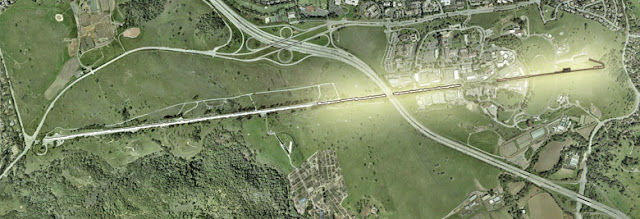The winners of “the biggest” prize go to the FELs. Taking the one in the U.S. soil as an example, a FEL powered by a two-mile-long linear accelerator (linac) in Stanford Linear Acceleration Center (SLAC) has a grand name associated with it -- Linac Coherent Light Source (LCLS). Technically speaking, it is a laser of more than two miles in length and many many tons in weight (I don’t think people actually weight this monster, figure 1). Basically, after SLAC’s linac accelerates very short pulses of electrons to 99.9999999 percent of the speed of light; the LCLS takes them through a 100-meter stretch of alternating magnets that force the electrons to undulate back and forth. This motion causes the electrons to emit X-rays. Since the electron motion is in phase with the field of the light already emitted, the fields add together coherently. As many as 10 trillion X-ray photons can be produced and squeezed into a bunch that’s a mere 100 femtoseconds long. This giant laser has a sibling across the Atlantic. In Europe, an x-ray free electron laser (European XFEL) shared by 14 countries is powered by a 2.1 km long superconducting linear accelerator.
 |
| Figure 1. The aerial view of the monster FEL laser in SLAC. |
Just a bit digression, an instrument (or experiment) involved 192 high power lasers is an unusual contender for this prize. Apparently, researchers in Lawrence Livermore National Laboratory’s (LLNL) National Ignition Facility (NIF) are trying to fulfill the dream of fusion by focusing many lasers in a capsule of size equivalent to a peanut. By squeezing so much energy in so little space (with the existence of hydrogen), they are optimistic about that the fusion is bound to happen.
Let’s swing to the other extreme. Nano-lasers with many different designs can proclaim the winners of the “smallest” prizes. A quantum cascade laser embedded in a microcavity and emitting THz radiation is one of the smallest lasers available (with a size of a few tens of microns). But the 44-nanometer "spaser – surface plasmon laser" will be very hard to beat. The device is a hybrid -- A bluish-green laser beam is shined into a suspension of gold nanoparticles. A layer of sodium silicate and an outer silica shell containing dye molecules surrounds each of these particles. When the gold is excited by the laser photons, collective oscillations of electrons on the surface, known as surface plasmons, are excited. The plasmons then excite the dye molecules, and subsequently the photons released from the dyes stimulate more plasmons on the gold at the same wavelength, causing the device to emit green laser light. How amazing is that!
DISCLAIMER
The opinions expressed herein are those of the author and do not represent the Optical Society of America (OSA) or any OSA affiliate.
No comments:
Post a Comment